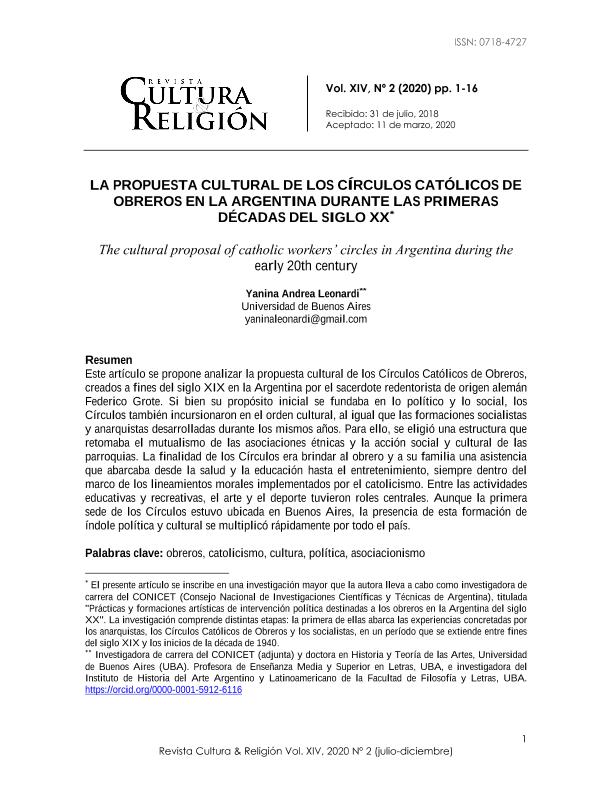Mostrar el registro sencillo del ítem
dc.contributor.author
Leonardi, Yanina Andrea

dc.date.available
2022-10-12T17:34:27Z
dc.date.issued
2020-12
dc.identifier.citation
Leonardi, Yanina Andrea; La propuesta cultural de los Circulos Católicos de Obreros en la Argentina durante las primeros décadas del siglo XX; Universidad Arturo Prat. Instituto de Estudios Internacionales; Cultura y Religión; 14; 2; 12-2020; 1-16
dc.identifier.issn
0718-4727
dc.identifier.uri
http://hdl.handle.net/11336/172745
dc.description.abstract
Este artículo se propone analizar la propuesta cultural de los Círculos Católicos de Obreros, creados a fines del siglo XIX en la Argentina por el sacerdote redentorista de origen alemán Federico Grote. Si bien su propósito inicial se fundaba en lo político y lo social, los Círculos también incursionaron en el orden cultural, al igual que las formaciones socialistas y anarquistas desarrolladas durante los mismos años. Para ello, se eligió una estructura que retomaba el mutualismo de las asociaciones étnicas y la acción social y cultural de las parroquias. La finalidad de los Círculos era brindar al obrero y a su familia una asistencia que abarcaba desde la salud y la educación hasta el entretenimiento, siempre dentro del marco de los lineamientos morales implementados por el catolicismo. Entre las actividades educativas y recreativas, el arte y el deporte tuvieron roles centrales. Aunque la primera sede de los Círculos estuvo ubicada en Buenos Aires, la presencia de esta formación de índole política y cultural se multiplicó rápidamente por todo el país.
dc.description.abstract
This article analyzes the cultural proposal of the Catholic Workers’ Circles, which were created in the late 19th century in Argentina by Redemptorist German priest Federico Grote. Although their initial purpose was based on the political and social spheres, the Circles also addressed matters related to cultural life, as did the socialist and anarchist groups formed during those same years. To that end, they chose a structure that returned to the mutualism of the ethnic and social and cultural action associations of parish churches. The purpose of the Circles was to provide the worker and his family with assistance that ranged from healthcare and education to entertainment, always within the moral guidelines provided by Catholicism. Art and sports played key roles in educational and recreational activities. The first headquarters of the Circles were located in Buenos Aires, but the presence of this political and cultural organization rapidly spread throughout the country.
dc.format
application/pdf
dc.language.iso
spa
dc.publisher
Universidad Arturo Prat. Instituto de Estudios Internacionales
dc.rights
info:eu-repo/semantics/openAccess
dc.rights.uri
https://creativecommons.org/licenses/by/2.5/ar/
dc.subject
OBREROS
dc.subject
CULTURA
dc.subject
CATOLICISMO
dc.subject
ASOCIACIONISMO
dc.subject.classification
Otras Artes

dc.subject.classification
Arte

dc.subject.classification
HUMANIDADES

dc.title
La propuesta cultural de los Circulos Católicos de Obreros en la Argentina durante las primeros décadas del siglo XX
dc.title
The cultural proposal of catholic workers’ circles in Argentina during the early 20th century
dc.type
info:eu-repo/semantics/article
dc.type
info:ar-repo/semantics/artículo
dc.type
info:eu-repo/semantics/publishedVersion
dc.date.updated
2022-10-11T19:40:10Z
dc.journal.volume
14
dc.journal.number
2
dc.journal.pagination
1-16
dc.journal.pais
Chile

dc.journal.ciudad
Iquique
dc.description.fil
Fil: Leonardi, Yanina Andrea. Consejo Nacional de Investigaciones Científicas y Técnicas; Argentina. Universidad de Buenos Aires. Facultad de Filosofía y Letras. Instituto de Historia del Arte Argentino y Latinoamericano; Argentina
dc.journal.title
Cultura y Religión
dc.relation.alternativeid
info:eu-repo/semantics/altIdentifier/url/https://www.revistaculturayreligion.cl/index.php/culturayreligion/article/view/820
dc.relation.alternativeid
info:eu-repo/semantics/altIdentifier/doi/http://dx.doi.org/10.4067/S0718-47272020000200102
Archivos asociados
